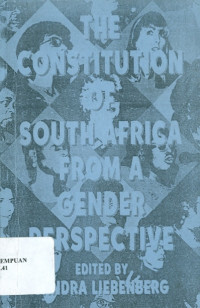
Text
The constitution of South Africa from a gender perspective
This book is a collection of edited versions of the papers presented at the conference. In exploring various constitutional themes affecting women, these papers either expressly or implicitly raise the question of the relation between legal rights and social change for women. The process of gender mainstreaming is especially important in a participatory democracy, as it enables international agreements in the area of gender to have clout. Gender is widely recognised as a marginalised issue, and the UN defines gender mainstreaming “as the process of assessing the implications for women and men of any planned action, including legislation, policies or programs, in all areas and at all levels. It is a strategy for making women’s as well as men’s concerns and experiences an integral dimension of the design, implementation, monitoring and evaluation of policies and programs in all political, economic and societal spheres so that women and men benefit equally, and inequality is not perpetuated”. (UN/DAW 1998:4) South Africa further attempted to pledge its commitment to the fight for gender equality through the Convention for the Elimination of All Forms of Discrimination Against Women, the Southern African Development Community Declaration on Gender and Development, the African Union Protocol on the African Charter on Human and People’s Rights on the Rights of Women in Africa, and the Constitution of South Africa which clearly stipulates the rights of equality. The latter came into effect in 1996. Following the Beijing Platform for Action, countries around the world set up institutions that would be responsible for the achievement of the aims of the agenda. South Africa’s National Policy Framework for Women’s Empowerment and Gender Equality of 2002, also known as the Gender Policy Framework, reflects South Africa’s vision for gender equality and how it intends to realize this ideal. The policy stipulates the overarching principles, practices and programs which will be integrated by all sectors of the South African government into their policies. This gender policy also details a strategy for gender mainstreaming and provides guiding principles for its implementation. Most importantly the policy details the long and short term mechanisms for determining the extent of gender justice and equality. This however, was undertaken in a very limited manner with many departments using the Employment Equity Act as a compliance measure for gender equality.
Availability
| KP.II-00168 | INT VII.41 CON | My Library | Available |
Detail Information
- Series Title
-
-
- Call Number
-
KP.II.SAN.C
- Publisher
- Cape Town : the Community Law Centre., 1995
- Collation
-
245 hlm.; 21 cm
- Language
-
English
- ISBN/ISSN
-
0-620-1965-6-4
- Classification
-
KP.II.
- Content Type
-
-
- Media Type
-
-
- Carrier Type
-
-
- Edition
-
-
- Subject(s)
- Specific Detail Info
-
-
- Statement of Responsibility
-
-
Other version/related
No other version available
File Attachment
Comments
You must be logged in to post a comment
 Computer Science, Information & General Works
Computer Science, Information & General Works  Philosophy & Psychology
Philosophy & Psychology  Religion
Religion  Social Sciences
Social Sciences  Language
Language  Pure Science
Pure Science  Applied Sciences
Applied Sciences  Art & Recreation
Art & Recreation  Literature
Literature  History & Geography
History & Geography